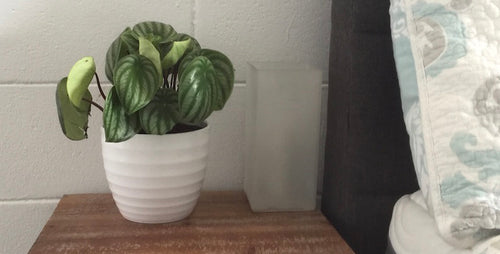Hoyas are super popular. In fact, many hoya lovers are simply obsessed with them. That’s because hoyas have so many forms and leaf looks. Commonly called wax plants, due to their firm shiny leaves, hoyas are beautiful, and so easy to grow. Take a look at some of the leaf and growth habit possibilities. See more about Hoya varieties here.

Almond Leaves
Many hoyas have beautiful almond-shape leaves. Perhaps the most common species, Hoya carnosa, features lovely large, glossy leaves that sprout along long vines. There are also forms of Hoya carnosa that have variegated leaves, including 'Variegata' (commonly called tricolor hoya, as well as Hoya Krimson Queen) and 'Rubra' (which is also commonly called Krimson Princess).
Hoya kentiana (shown here) features long, slender foliage similar to Ficus Alii.
Tip: Hoyas prefer bright, indirect light and are fairly drought tolerant.
Round Leaves
Some hoyas also sport nearly round leaves. (In fact, there is a variety called ‘Round Leaves’.)
Here at Costa Farms, we grow Hoya curtisii (commonly called Stripes hoya). It's a charming selection that has dark green leaves (with pointed ends) playfully splashed with silver.
Tip: If you give them bright light (indirect light is best, especially if you live in the South), most hoya varieties will produce clusters of star-shaped, fragrant flowers. These plants typically do not bloom well -- if at all -- if they do not receive enough light. 
Curly Leaves
If you're looking for a completely different look, the crinkled, curled leaves of Hoya compacta create quite a stir among houseplant lovers. This type of hoya is also called Rope Plant. There are several varieties available:
Hoya compacta 'Regalis' has twisted green leaves variegated with creamy centers.
Hoya compacta 'Crispa Variegata' has tight, curled and twisted leaves variegated with creamy-white edges.
Tip: Hoya plants are slow growers compared to many houseplants. Varieties that have leaves variegated with white, cream, gold, yellow, or other colors are typically even slower yet because the leaves have less chlorophyll. 
Mounding or Hanging
Most hoyas climb if you give them a support to grow up. But many, especially those with compact growth, can be mounded or trailing if you grow them in hanging baskets.
Discover more about raising hoyas:
5 Tips for Raising Healthy Hoyas
How to Care for Your Hoya
Written by Karen Weir-Jimerson

















